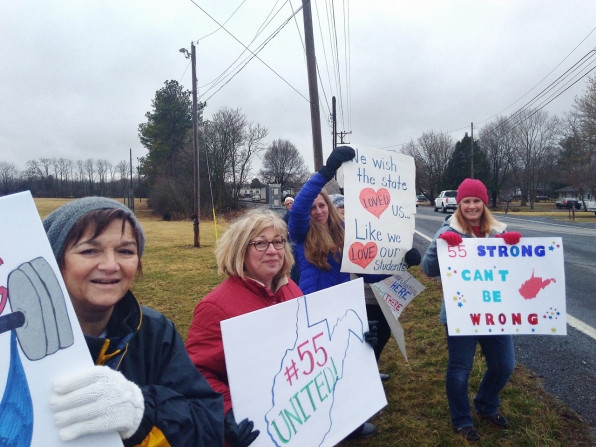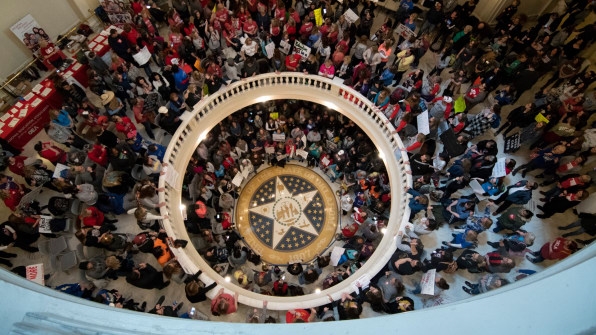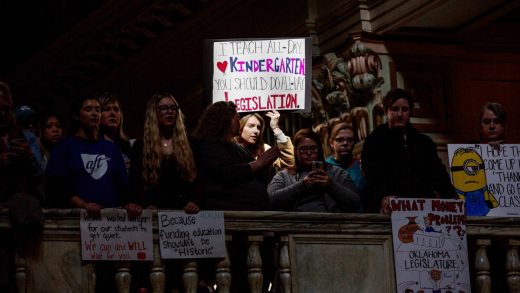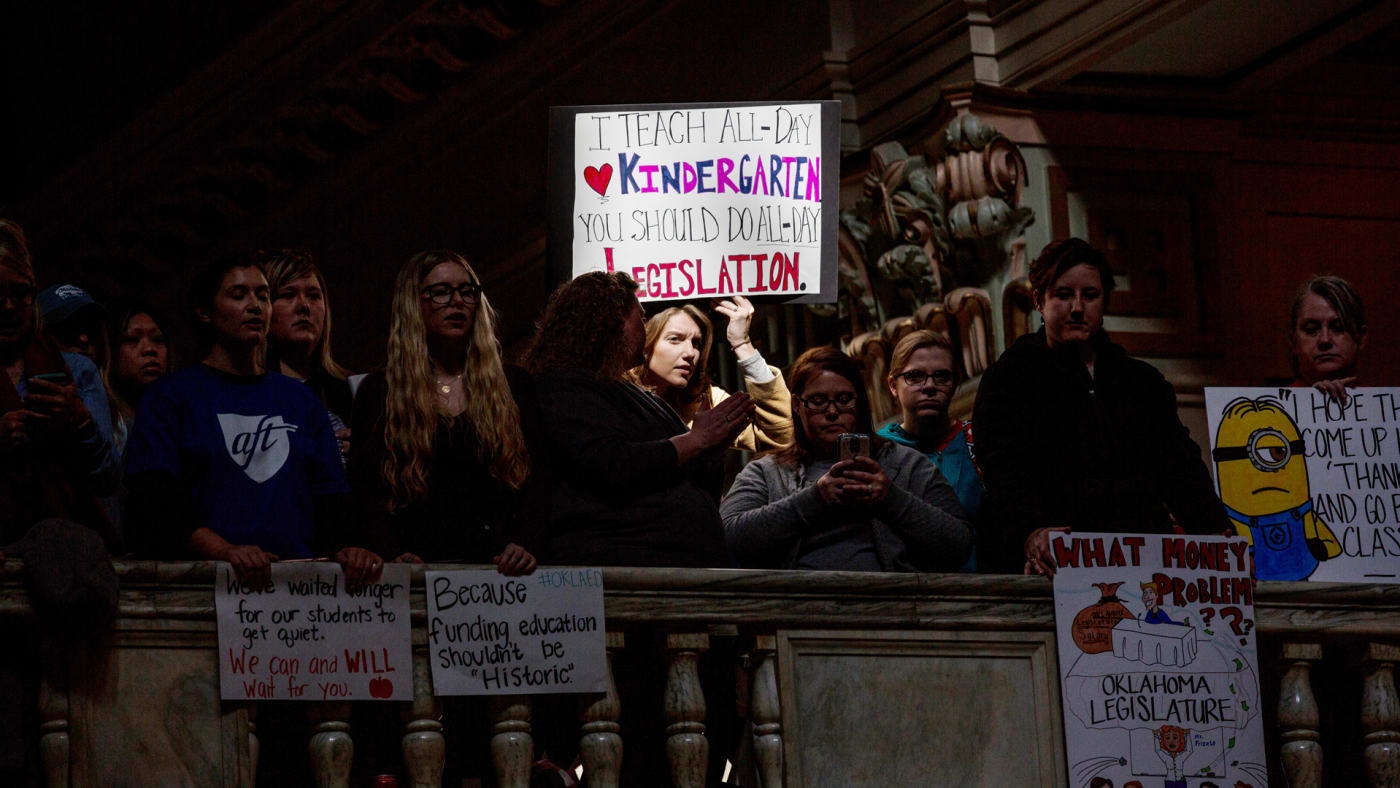The Teacher Strikes Show That Workers Are Really, Finally, Fed Up
First there was West Virginia, where teachers in all 55 counties went on strike for nine days. Now, there’s Oklahoma, where thousands have walked out. And Kentucky. There are rumblings of a teacher strike in Arizona.
The strikes share many commonalities: Dissatisfaction over low salaries and constricted benefits have united teachers and public employees, who took to social media channels like Facebook to galvanize and coordinate walkouts to call for raises and improved benefits. While teachers’ unions have supported the strikes, it’s been a broad grassroots coalition of teachers–without their unions leadership–that have guided the demands and how they’ve gone about asking for them, says Ryan Frankenberry, founding director of the West Virginia chapter of the Working Families Party, which supported the strikes. “We’ve seen teachers form private Facebook groups to organize,” he says. “Every time they invite someone to join, that’s escalating the movement.” Teachers organizing now in Kentucky, Oklahoma, and Arizona have followed a playbook set by the West Virginia teachers, many of whom have joined the other states’ Facebook groups to offer advice and encouragement.
But the teachers’ strikes also have roots in a much larger fight against the political and economic systems that have, for decades, been chipping away at wages and benefits for workers, says Annelise Orleck, a history professor at Dartmouth who specializes in labor movements. “This is a grassroots uprising made up of people who have done what you were supposed to do to achieve the American dream–they got an education, many of them advanced degrees–and yet in the last 30 years or so, the bottom has been cut out from them by the legislatures,” Orleck says.

“For public sector, there’s a pretty simple pattern we’ve been seeing,” she says. Legislatures in more conservative states have granted tax cuts to corporations, which have constricted budgets. To balance the budgets, the things that get cut are salaries and benefits. In the private sector, there’s often a similar story: Companies keep salaries and benefits low–or outsource work to independent contractors who don’t get any benefits at all–in order to maximize profitability and return money to shareholders.
That leaves us, Orleck says, with a broad coalition of workers, both public and private sector, whose livelihoods have suffered for the benefit of corporations. And as the teachers’ strikes–and scores of labor strikes around the world–have shown, that system has reached its breaking point.
Orleck recently wrote a book called We Are All Fast-Food Workers Now: The Global Uprising Against Poverty Wages. In it, she describes how the expansion of large multinationals like McDonalds and H&M has been fed by low wages and the stripping of workplace benefits and protections. But in turn, those workers, many of them women, have, like the striking teachers, begun to unify through social media to protest and expose the exploitative policies of their employers, sometimes without union support. They’ve gained some concessions–H&M promised to pay all workers in its supply chain a fair living wage by this year, for instance–and continue to agitate to hold companies to their promises.
“What’s interesting to me is that with the teachers, we’re starting to see real strikes,” Orleck says. And some have been wildcat strikes, undertaken without support or authorization from their unions, many of which have been weakened under conservative labor policies in the states. “From all the workers and teachers, I’ve heard the same line from people I’ve asked, ‘Isn’t this risky?’” Orleck says. “They’ve all said: ‘We have nothing left to lose.’”
The fact that both the global labor strikes and the teacher strikes are led largely by women is significant: Not only are these strikes about labor and compensation overall, but they also signal a dissatisfaction with gender inequity. Many of the workers leading strikes around the world come from sectors like hotel and domestic work, which are majority-female, Orleck says, and “as soon as teaching began to be seen as a women’s profession, salaries dropped.”

The strikes show that gender inequity, too, has reached a breaking point. And despite the serious ills of social media platforms like Facebook, they have also allowed workers to unite organically in ways that were not possible before. And this capability, Orleck says, will be what brings about the end of the exploitative practices that have led to the strikes in the first place.
And the strikes are working: In Oklahoma, for instance, the teachers’ strike has precipitated a radical overhaul in the state’s tax framework. As New York Magazine points out, this is a state that, in 2016, responded to a $1.3 billion budget shortfall by cutting taxes on the wealthy, and renewing existing tax breaks for oil and gas companies. Last week, in response to the teachers’ demands, the legislature voted to raise taxes on those companies.
How can this momentum continue? Unions will need to modernize, both to keep up with the demands of their rank-and-file members, and to advocate more effectively on their behalf. While unions’ power has faded in recent decades (due to anti-labor policies in many states), the teachers’ strikes “gave the unions back some power by motivating their membership,” Frankenberry says.
The West Virginia chapter of the American Federation of Teachers is now conducting a listening tour with teachers around the state in the aftermath of the strikes, Frankenberry says. He sees that as a positive step, but also thinks unions could benefit by adopting a digital network that would allow them to be more responsive and connected to their members, and that would allow workers to continue to collectively organize without the attendant threat of surveillance on platforms like Facebook. The National Education Association chapters in Arizona and Oklahoma, for instance, have both joined The Action Network, the organizing platform used by the Women’s March and many other post-Trump activist movements to coordinate events and ongoing organizing.
“What we’re seeing now is these conservative policies coming back to bite leaders,” Frankenberry says. “Actual working people are realizing that they’re not being benefitted by all of these tax cuts for corporations–and this goes far beyond public employees and teachers,” he says. “If the legislature and the government have this little regard for what their own employees–public employees–are making, imagine how little they’re thinking about regular people depending on companies for their paycheck,” he says. Adds Orleck: “We are going to need a real moral reckoning in our culture, and the teachers are the right ones to bring us there.”
(23)



